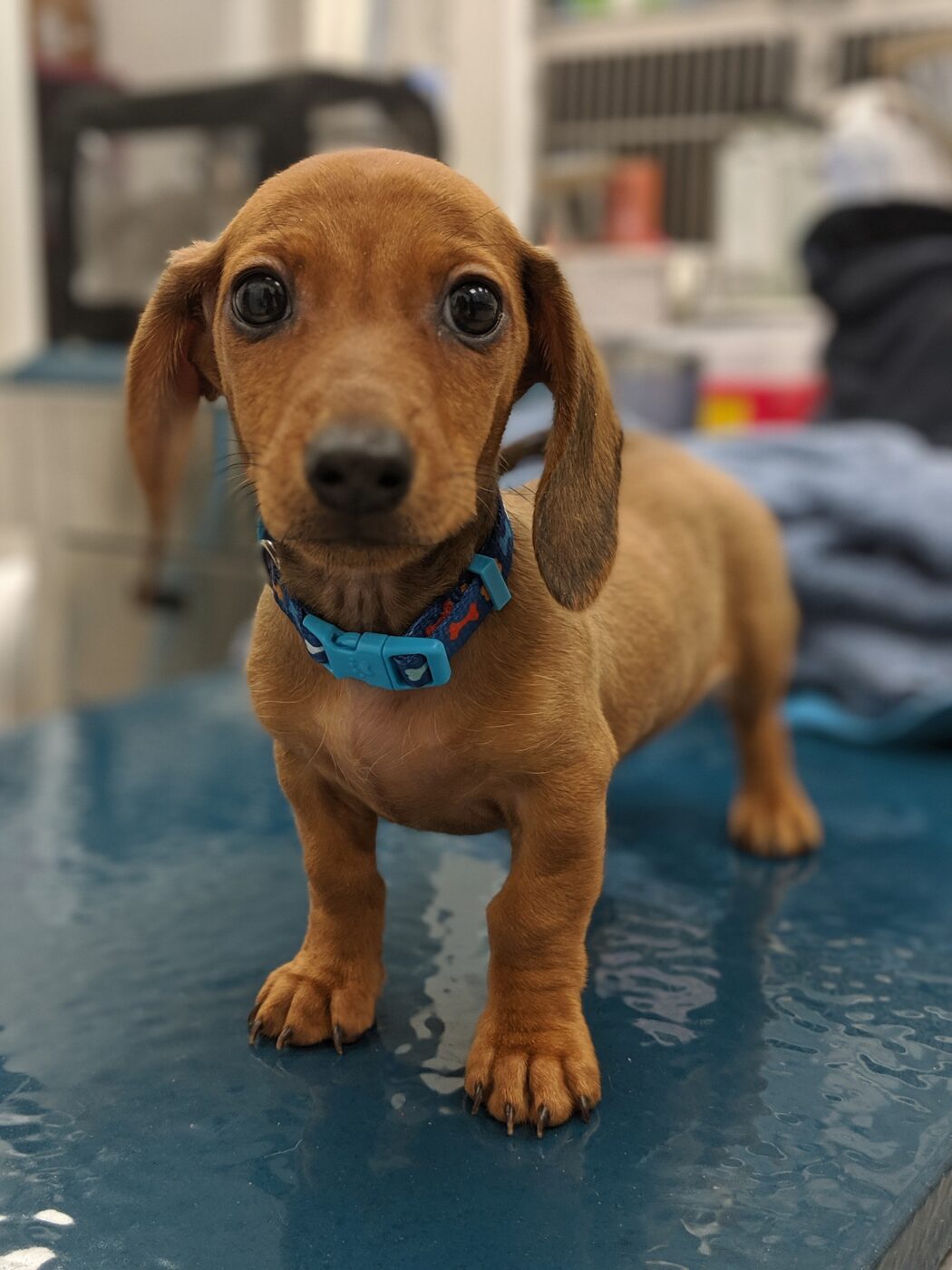iHeartDogs is reader-supported. When you buy via links on our site, we may earn an affiliate commission at no extra cost to you.

Dachshunds, or “wiener dogs” as they’re often affectionately referred to, are a popular breed for a reason. They’re adorable, adaptable, and curious dogs. And who doesn’t love that small sausage shape?
Unfortunately, the Dachshund breed is predisposed to certain medical conditions. While these health issues can be expensive to treat, you may be able to cover the high costs if you invest in pet insurance early.
It’s easy to feel overwhelmed when it comes to choosing the right pet insurance plan for your beloved Dachshund. This guide will help you select a plan that covers everything you want it to, so you can be there for your dog when they need you most.
Compare The Top 9 Pet Insurance Plans for Your Dachshund Using our Free No-Obligation Quote Tool below
The simplest way to compare pet insurance prices is to use our tool below. The comparison tool will show you quotes from the top 9 pet insurance carriers including Trupanion, Pets Best, Lemonade, ManyPets, FIGO, HealthyPaws, Prudent Pet, Spot, and Embrace pet insurance.
How Much Does Pet Insurance for a Dachshund Cost?
Below are some sample pet insurance plans for a 1-year-old male Dachshund using the zip code 75001 (Texas) as an example.
- Pets Best – $28.29 per month
- Embrace – $35.77 per month
- Healthy Paws – $29.10 per month
- ManyPets – $25.87 per month
Ultimately, your plan’s premium will depend on several factors, including your dog’s age, size, and breed, as well as where you live. You also want to know what type of coverage your plan has and if it will help with Dachshund-specific health problems. Let’s get more into those medical conditions and how much you can expect to pay to treat them.
Common Health Problems Associated With Dachshunds
Intervertebral Disk Disease (IVDD) in Dachshunds
When a disc between the vertebrate in a dog’s spinal column deteriorates and calcifies, it can rupture with too much movement. A diseased or ruptured disc can press on your Dachshund’s spinal column, leading to extreme pain and even paralysis.
Because of their comparatively short legs and longer backs, IVDD affects Dachshunds more than any other breed. About 1 in 4 Dachshunds will be affected.
Obesity in Dachshunds
Gaining too much weight can be especially harmful to a Dachshund, again due to their short legs and longer backs. Being overweight can make the possibility of your Dachshund developing IVDD higher. Dachshunds that have been spayed or neutered are at higher risk for obesity.
Epilepsy in Dachshunds
Abnormalities in the brains of epileptic dogs will lead to ongoing seizures, and treatment will depend on the underlying causes. This seizure disorder will require your Dachshund to go on lifelong medication once diagnosed.
Acanthosis Nigricans (AN) in Dachshunds
This disease is said to be unique to Dachshunds. It’s a pigmentation disorder that causes the skin of the dog’s armpits, legs, and groin to darken and thicken. As a consequence, these areas of the skin can get infected.
Eye Diseases in Dachshunds
Sadly, your wiener dog is likely to develop one of a few eye problems later in life. Progressive retinal atrophy (PRA) is a degenerative eye disorder that leads to eventual blindness from the loss of photoreceptors at the back of the eye. This can affect your dog’s depth perception and make them hesitant to walk at night.
Your Dachshund may also develop cataracts, which is a grayish-white film that forms over the lens of the eye. Surgery can remove cataracts, but it’s expensive, and it is possible for a dog to live comfortably with some treatment and adjustments.
RELATED: How To Help Your Blind Dog Adjust
Cushing’s Disease in Dachshunds
This disease occurs when the body produces too much of a hormone called cortisol. Cushing’s largely affects middle-aged to senior dogs, and you may notice your dog is extra thirsty or losing patches of hair. Your Dachshund may also urinate more frequently and have accidents.
Bloat in Dachshunds
Bloat occurs when your Dachshund’s stomach swells from excessive gas. When the condition worsens, the stomach can twist and obstruct blood flow to the heart. At that point the condition is life-threatening.
If you notice any of these warning signs, you should take your dog to the vet right away:
- Swollen belly
- Rapid heartbeat
- Difficulty breathing
- Collapse
Typical Costs Of Treating Health Issues In Dachshunds and How Pet Insurance Can Help
If left untreated, certain conditions can result in long-term consequences, which ultimately make them more expensive to manage and treat. Knowing the signs and symptoms of these conditions common in Dachshunds can help you catch them early. When in doubt, take your pup to the vet to have them diagnosed.
Many of the health issues listed above can be very expensive to treat, especially when surgery is required. Here are just some sample veterinary expenses:
- IVDD Costs: Caught early enough, IVDD can be treated with non-invasive treatments like pain medication and exercise control. In severe cases however, surgery can cost between $1,500 and $4,000. Those costs also don’t include the price of X-rays and other imaging techniques, which can add hundreds to thousands of dollars onto your bill.
- Epilepsy Costs: Epilepsy treatments range based on the severity of the condition. It could involve a special diet, long-term or permanent medication, nerve stimulation, and even surgery to remove brain tumors. Ultimately, the goal of epilepsy treatment is to decrease the frequency, severity, and duration of the seizures. In simple cases, this treatment plan may cost you $200 to $500 per year. In severe cases, however, you could pay up to $15,000 in surgery costs.
- Acanthosis Nigricans (AN) Costs: The treatment for AN depends on whether the disease is a primary or secondary one. If your Dachshund suffers from the primary AN, it can be controlled with topical products. If the AN results from your dog’s preexisting condition, treating that issue will likely get rid of the AN too. So, it could be relatively inexpensive to treat, or you could spend hundreds to thousands treating the primary condition.
- Cushing’s Disease Costs: Some of the higher costs involved with Cushing’s are in the diagnostics, since it can be hard for vets to initially determine what’s affecting your Dachshund. Ongoing treatment for the disease can range from $50 to $200 per month. They’ll also need frequent bloodwork to see if the drugs are working.
- Bloat Costs: Unfortunately, treating this medical condition is extremely pricey. If your dog’s stomach has twisted, they’ll need major surgery. Your Dachshund will also need stomach decompression and fluid therapy to counteract shock. Pet insurance with emergency coverage can literally be life-saving in this case.
- Eye Disease Costs: Cataract surgery can cost between $2,700 and $4,000 on average. Sadly, there’s currently no effective treatment for PRA, but there are home adjustments and wearable halos to make your blind dog’s life more comfortable.
What Is Pet Health Insurance And Why Do I Need It For My Dachshund?
Pet health insurance works very similarly to human health insurance. Your policy quote will range in monthly price, depending on your dog’s breed, age, and where you live. Typically, you’ll spend around $25-$45 per month as a pet parent.
Pet insurance is mainly about peace of mind, knowing you won’t be totally overwhelmed in case of an emergency. Enrolling even when your dog is young and healthy will ensure you have plenty of coverage when they need expensive medical care later. If you choose a plan more suited to your dog’s particular breed, you’ll be more prepared when something happens later on in their life.

Some plans cover accidents and illnesses, while others only cover accidents. Certain plans do cover breed-specific illnesses, and others do not. It all depends on what type of coverage you choose. You can get quotes from multiple insurance companies with no obligation to commit with our free pet insurance comparison tool.
Whatever plan you choose, you’ll feel better knowing you can take care of your dog when they need you most. Plus, you won’t have to suddenly shell out thousands of dollars. Learn more about how pet insurance works here.
Pet Insurance Carrier Comparisons
- 9 Best Pet Insurance Plans for Dogs
- Best Cheap Pet Insurance
- Trupanion Vs. Pets Best Pet Insurance
- Trupanion Vs. Lemonade Pet Insurance
- HealthyPaws Vs. Embrace Pet Insurance
- HealthyPaws Vs. Trupanion Pet Insurance
- Embrace Vs. Trupanion Pet Insurance
- Embrace Vs. Lemonade Pet Insurance
- Trupanion Vs. FIGO Pet Insurance
- Prudent Pet Vs. Trupanion Pet Insurance
- Embrace Vs. ManyPets Pet Insurance
- Embrace Vs. FIGO Pet Insurance
- Prudent Pet Vs. Embrace Pet Insurance
- HealthyPaws Vs. ManyPets Pet Insurance
- HealthyPaws Vs. FIGO Pet Insurance
- Prudent Pet Vs. HealthyPaws Pet Insurance
- HealthyPaws Vs. Lemonade Pet Insurance
- Pets Best Vs. ManyPets Pet Insurance
- Pets Best Vs. FIGO Pet Insurance
- Prudent Pet Vs. ManyPets Pet Insurance
- Prudent Pet Vs. Pets Best Pet Insurance
- Embrace Vs. Pets Best Insurance
- HealthyPaws Vs. Pets Best Pet Insurance
- ManyPets Vs. Lemonade Pet Insurance
- Lemonade Vs. FIGO Pet Insurance
- Trupanion Vs. ManyPets Pet Insurance
- ManyPets Vs. FIGO Pet Insurance
- Lemonade Vs. Pets Best Pet Insurance
- Prudent Pet Vs. Lemonade Pet Insurance
- Prudent Pet Vs. FIGO Pet Insurance
Breed Pet Insurance
- Pet insurance for Akitas
- Pet insurance for Alaskan Malamutes
- Pet insurance for American English Coonhounds
- Pet insurance for American Staffordshire Terriers
- Pet insurance for Australian Cattle Dogs
- Pet insurance for Australian Shepherds
- Pet insurance for Basset Hounds
- Pet insurance for Beagles
- Pet insurance for Bernese Mountain Dog
- Pet insurance for Bichon Frises
- Pet insurance for Bloodhounds
- Pet insurance for Border Collies
- Pet insurance for Boston Terriers
- Pet insurance for Boxers
- Pet insurance for Bulldogs
- Pet insurance for Bullmastiffs
- Pet insurance for Bull Terriers
- Pet insurance for Cane Corsos
- Pet insurance for Cavaliers
- Pet insurance for Chesapeake Bay Retrievers
- Pet insurance for Chihuahuas
- Pet insurance for Chinese Crested Dogs
- Pet insurance for Chow Chows
- Pet insurance for Cocker Spaniels
- Pet insurance for Collies
- Pet insurance for Corgis
- Pet insurance for Dachshunds
- Pet insurance for Dobermans
- Pet insurance for Dogue De Bordeaux
- Pet insurance for English Springer Spaniels
- Pet insurance for French Bulldogs
- Pet insurance for German Shepherds
- Pet insurance for German Shorthaired Pointers
- Pet insurance for Goldendoodles
- Pet insurance for Golden Retrievers
- Pet insurance for Greyhounds
- Pet insurance for Great Danes
- Pet insurance for Great Pyrenees
- Pet insurance for Havanese
- Pet insurance for Huskies
- Pet insurance for Jack Russells
- Pet insurance for Labrador Retrievers
- Pet insurance for Labradoodles
- Pet insurance for Lhasa Apsos
- Pet insurance for Maltese
- Pet insurance for Mastiffs
- Pet insurance for Miniature Pinschers
- Pet insurance for Mixed Breeds (small)
- Pet insurance for Mixed Breeds (medium)
- Pet insurance for Mutts
- Pet insurance for Newfoundlands
- Pet insurance for Old English Sheepdogs
- Pet insurance for Papillons
- Pet insurance for Pekingese
- Pet insurance for Pit Bulls
- Pet insurance for Pomeranians
- Pet insurance for Poodles
- Pet insurance for Pugs
- Pet insurance for Rhodesian Ridgebacks
- Pet insurance for Rottweilers
- Pet insurance for Saint Bernards
- Pet insurance for Samoyeds
- Pet insurance for Schnauzers
- Pet insurance for Shar-Peis
- Pet insurance for Shelties
- Pet insurance for Shiba Inus
- Pet insurance for Shih Tzu
- Pet insurance for Staffordshire Bull Terrier
- Pet insurance for Vizslas
- Pet insurance for Weimaraners
- Pet insurance for Westies
- Pet insurance for Whippets
- Pet insurance for Yorkies
Pet Insurance by City
- Pet Insurance in San Diego
- Chicago Pet Insurance
- New York City Pet Insurance
- Pet Insurance in Seattle
- Pet Insurance in Los Angeles
- Pet Insurance in Austin
- Pet Insurance in San Antonio
- Pet Insurance in Miami
- Pet Insurance in Philadelphia
- Pet Insurance in Sacramento
- Pet Insurance in Orlando
- Pet Insurance in San Francisco
- Pet Insurance in Houston
- Pet Insurance in Dallas
- Pet Insurance in Tampa
- Pet Insurance in Pittsburgh
Pet Insurance by State
- Pet Insurance in California
- Pet Insurance in Texas
- Pet Insurance in Florida
- Pet Insurance in Pennsylvania
- Pet Insurance in Washington State
- Best Pet Insurance in Michigan
- State of Delaware Pet Insurance
- Pet Insurance in NC
- Pet Insurance in NJ
- Pet Insurance in Colorado
- Pet Insurance in Ohio
- Pet Insurance in Oregon
- Pet Insurance in Indiana
- Pet Insurance in Oklahoma
- Pet Insurance in Utah
- Pet Insurance in New York
- Pet Insurance in Massachusetts
- Pet Insurance in Arizona
- Pet Insurance in Minnesota
- Pet Insurance in Connecticut
- Pet Insurance in Wisconsin
- Pet Insurance in Hawaii
- Pet Insurance in Iowa
- Pet Insurance in New Hampshire
- Pet Insurance in Alabama
- Pet Insurance in Maine
- Pet Insurance in Maryland
- Pet Insurance in Rhode Island
- Pet Insurance in Arkansas
- Pet Insurance in Illinois
- Pet Insurance in Nebraska
- Pet Insurance in Alaska
- Pet Insurance in Louisiana
- Pet Insurance in South Carolina
- Pet Insurance in Vermont
- Pet Insurance in Georgia
- Hemp oil for dachshunds - 5 things to know
- 10 best supplements for a senior dachshund
- Flea & tick meds for a dachshunds
- Is your dachshund suffering in silence from joint pain?
- 10 natural ways to reduce your dachshund's joint pain / arthritis
- At what age should I give my dachshund a joint supplement or glucosamine?
- Best joint supplements for dachshunds
- Improve your dachshund's skin and coat with this one simple hack
- How to help your dachshund's allergies & itchiness
- 6 natural ingredients to reduce your dachshund's allergies
- 8 ways stop your dachshund from scratching
- 7 ways to calm your anxious dachshund
- 6 remedies for for your dachshund upset stomach, gas, vomiting, or diarrhea
- 3 simple ways to clean your dachshund's teeth
- 7 dental chews or toys to clean your dachshund's teeth
- Help for a picky eater dachshund
- Top 9 pet insurance plans for dachshunds

 Toledo, United States.
Toledo, United States.